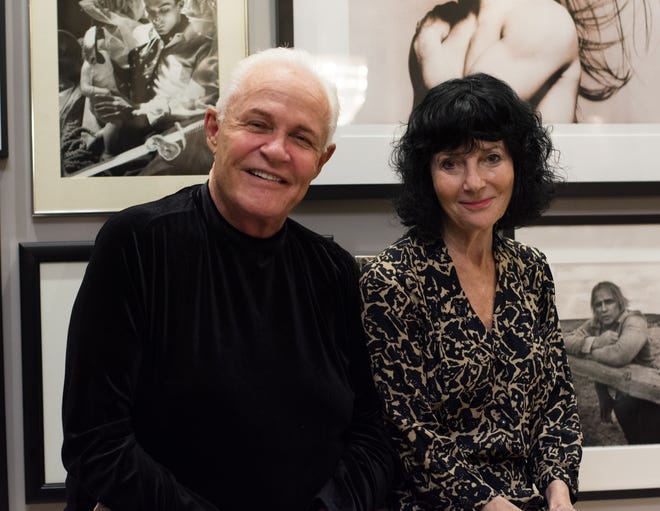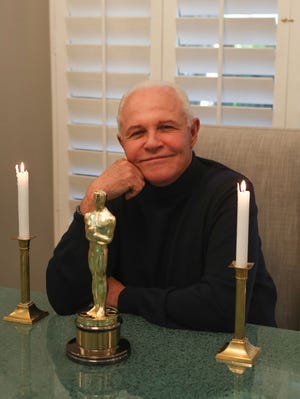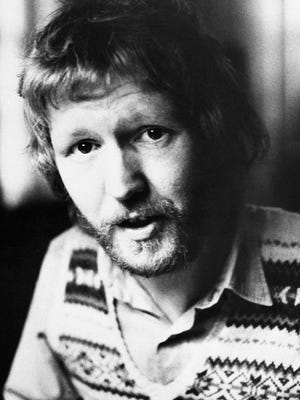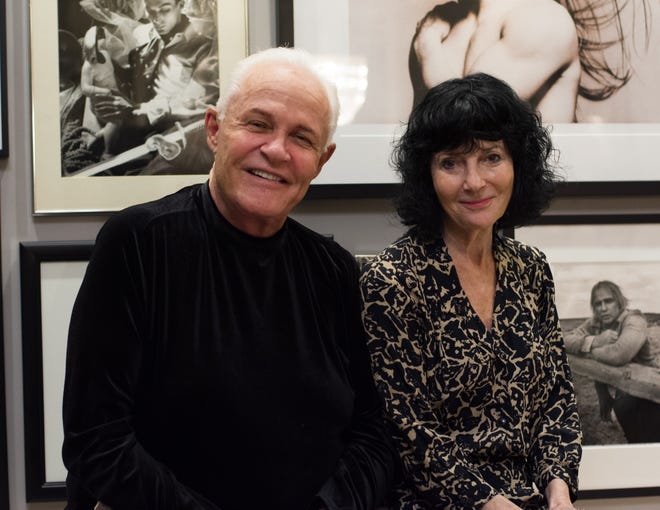
During the Vietnam War in 1969, the U.S. was in political chaos and social upheaval, but arts and culture were thriving. When the provocative film “Midnight Cowboy” was released that year, it represented a shift in American culture towards youth, masculinity and sexuality.
Based on James Leo Herlihy’s 1965 novel of the same name, the film was directed by the late John Schlesinger and featured actors Jon Voight and Dustin Hoffman. A new documentary by filmmaker Nancy Buirski, “Desperate Souls, Dark City and the Legend of the Midnight Cowboy” explains how this low-budget film changed cinema and turned Hollywood studios upside down.
“Desperate Souls, Dark City and the Legend of Midnight Cowboy” will screen on Saturday during the Palm Springs International Film Festival. (Editor’s note: The screening is sold out, but check psfilmfest.org this weekend to see if it makes it to the Best of the Fest screenings on Monday for another chance to view it.)
“Midnight Cowboy” is about Joe Buck (Voight), a man from Texas dressed in cowboy attire arriving in New York to be a male prostitute. But when he meets the street-smart con-man Ratso (Hoffman), who scams Joe out of $20 to introduce him to a pimp that turns out to be a crazed street preacher, Joe is on his own in navigating his sexual encounters with both men and women. Joe later hunts Ratso down and the two enter a business partnership while occupying an apartment that Ratso is squatting in.
Even though “Midnight Cowboy” earned an X-rating upon its release, the film earned $44 million at the box office against a budget of $3 million, was nominated for seven Academy Awards and won three. It’s also listed on American Film Institute’s 100 greatest films of all time.
It’s also the film in which Hoffman delivers the famous line of “I’m walkin’ here!” while crossing the street, which has been referenced in films such as “Forrest Gump” and has become a phrase often used to mock New Yorkers’ accents.

When asked what can be said about the iconic film that hasn’t already been said before, Buirski and Rancho Mirage photographer Michael Childers, the latter of whom was married to Schlesinger and worked on the film as a director’s assistant, each have their own opinions of why the film is still relevant today.
“One of the reasons I made the movie is I wanted to excavate why people were so touched by it back in the day and continue to be,” Buirski said. “I think (what) we tried to bring to it was the sense that films that have lasting power are not made in a vacuum. What was it that surrounded that film? What happened in that era that made that film inevitable? What kind of impact did it have on the next era?”
Childers said the reception to “Midnight Cowboy” is similar to another breakthrough independent film that came out that same year, “Easy Rider,” a drug culture film featuring Peter Fonda and Dennis Hopper on a motorcycle adventure from Los Angeles to New Orleans with money made from a large cocaine deal.
“These low-budget films that cost nothing suddenly made millions and Hollywood didn’t know what happened, but there was a social revolution at the time. Martin Luther King and Robert Kennedy were assassinated, (the rise of) Abbie Hoffman and the riots everywhere. There were things happening in America and things were in turmoil.”
Voight appears in the documentary but Hoffman doesn’t
While filming “Desperate Souls, Dark City and the Legend of Midnight Cowboy,” Buirski said Voight was more than willing to discuss the film, but Hoffman was unavailable, so his narrative is instead included via archived audio clips of the actor discussing “Midnight Cowboy.”
Hoffman had just starred in the 1967 film “The Graduate” and was on the rise in Hollywood at the time of the film. Both actors were nominated for Best Actor at the Oscars in 1970, but Hoffman didn’t appear at the ceremony. John Wayne, who was terminally ill with cancer, beat both actors for his performance in “True Grit.”

Many believe Hoffman isn’t pleased with his performance in “Midnight Cowboy,” but Buirski explained a different side of that story. After the success of “The Graduate,” Hoffman’s profile was only beginning to rise, and he was performing in off-Broadway productions. He needed a film making a bold statement to show his acting abilities, and thus “desperately wanted to do ‘Midnight Cowboy.'”
“At the time, (Hoffman) was a little upset because there were scenes cut from the film that he was sorry to see cut,” Buirski said. “I think he felt like he would have had a larger role, but the film is about the cowboy. Dustin was a secondary role and I’m not sure he was thrilled with that. But I think years later, he looks back on it and recognizes what an important role it was for him.”
Voight was in desperate need of a breakthrough role after TV appearances in shows such as “Gunsmoke” and “Naked City,” as well as his 1967 film debut in “Fearless Frank.” “Midnight Cowboy” became Voight’s quantum leap that established him in Hollywood. Fifty years later, Buirski said Voight is “still very loving of ‘Midnight Cowboy’”
‘Midnight Cowboy’ is not a gay film
Even though “Midnight Cowboy” is remembered for its sexual scenes featuring two men, both Childers and Buirski said it’s not a “gay film.” The story is more about friendship and the plight of urban sex workers living in peril. Voight and Hoffman’s characters aren’t written as lovers; the pair share a difficult but caring friendship, which strengthens as Ratso’s health breaks down.
Schlesinger’s nephew, writer and historian Ian Buruma, disagrees with the “gay film” label and so does Voight.
“Ian speaks very movingly about the fact that if it were a gay film and were convinced these two men were lovers, that would have removed a lot of ambiguity and sensitivity from the film,” Buirski said. “What it tries to promote is there can be alternative relationships that are not necessarily gay. There can be loving, tender relationships between men. Introducing that concept alone is groundbreaking.”

Schlesinger followed “Midnight Cowboy” with “Sunday Bloody Sunday,” which Childers said was “a huge breakthrough” for gay cinema because it featured the first on-screen kiss between two men and added the path to that film through “Midnight Cowboy” being released months before the Stonewall Riots in New York.
“Stonewall broke the lid off gay subjects. Film, society, relationships and everything changed. ‘Sunday Bloody Sunday’ hit the crest of Stonewall when it was released and had a big run for over a year,” Childers said. “The problem with gay culture (and ‘Midnight Cowboy’) is John read all these books delving into a third culture, which was (hustler culture) in Times Square, Hollywood Boulevard and all that, but he always said ‘This is not a gay movie.’ It’s been accused of being a gay movie and an anti-gay movie, and it’s ridiculous.”
The “Midnight Cowboy” soundtrack features arrangements by John Barry and songs performed by Elephant Memory, Leslie Miller and The Groop, but is best remembered for Harry Nilsson’s cover of singer-songwriter Fred Neil’s 1967 song “Everybody’s Talkin.'”
“John said ‘You have to listen to this Nilsson record called ‘Everybody’s Talkin,”and I was like, ‘Oh my god, we’ve had too much Chardonnay and smoked too many joints,'” Childers said. “But if you listen to the ‘Midnight Cowboy’ theme by John Barry, it’s very close to Bob Dylan’s ‘Sad-Eyed Lady of the Lowlands.’ But these songs influenced and brought about a great score by John Barry.”

Childers said there were a lot of songs thrown out from the film, such as some written by Joni Mitchell and Bob Dylan, but Schlesinger wasn’t going to use those recordings just because they were attached to big names. However, he did want the original Fred Neil version of “Everybody’s Talkin'” and ultimately went with Nilsson’s version, which reached No. 6 on the Billboard Hot 100 chart. Childers said the decision came down to “finances.”
“(The record company) was asking for too much money to use the song, and Harry said he could do his own version cheaper,” Childers said. “Harry Nilsson was just a genius.”
The ‘anti-American dream’
For several decades, many young people across the U.S. pursuing a bohemian lifestyle, or who had dreams of becoming actors, musicians, artists or better opportunities in general, went to Los Angeles or New York. Childers said New York was his dream while growing up in North Carolina.
“I read the New York Times every day when I was a junior in high school and my dream was New York and Broadway. I wanted to go there more than anywhere in the world.” Childers said. “If you wanted to be in the rat race or succeed, New York was everything.”
Even though Joe decides to leave Texas for New York in “Midnight Cowboy,” Buirski points out the “anti-American dream” twist because of the cold weather, homeless population and the struggles of both characters.
“Joe comes from Texas to New York, not California. Then Joe and Ratso decide they’re going to Florida and push Los Angeles aside,” Buirski said. “When you don’t have heat, that’s where you want to go and it’s a lot closer and cheaper than going to Los Angeles.”
One breakthrough for “Midnight Cowboy” was is the cinematography. Schlesinger, who directed the documentaries “Terminus” and “Israel: A Right to Live” observed and filmed New York in a way no other director had at the time. He used hidden cameras placed throughout 42nd Street and in the subway. It was also the first time a steadicam and fisheye lens was used. Childers also credits cinematographer Adam Holender for much of the filmmaking process.
“Adam was 20 years ahead of his time and brought techniques that would later succeed in music videos,” Childers said. “He did some amazing things with grainy film, infrared, wide-angle and fisheye lenses and great camera work.”
In 2018, Criterion Collection released a “Director-Approved” version of “Midnight Cowboy” with additional features such as a short film, a documentary on screenwriter Waldo Salt, interviews and more. An expanded version of the soundtrack was released in 2020.
When asked if the allure of “Midnight Cowboy” will last another 50 years, Childers said he believes it will.
“The movie plays so well with the humor, the cries and the pathos of these great characters,” Childers said. “There’s a bond between these two outcasts and they hold on to each other with compassion and humanity. The last scene where Dustin’s eyes are reflected in the window and Joe Buck sees him in the window, it’s emotional.”
Desert Sun reporter Brian Blueskye covers arts and entertainment. He can be reached at brian.blueskye@desertsun.com or on Twitter at @bblueskye.








